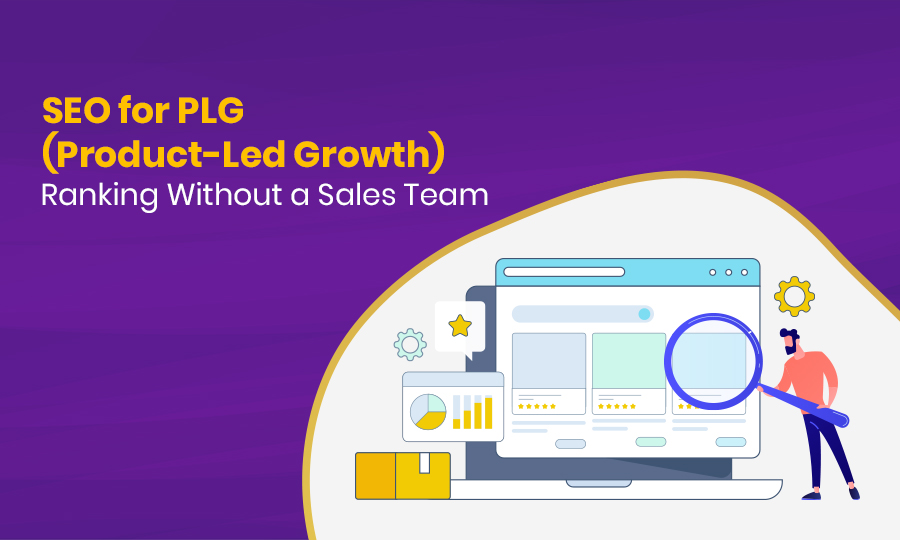In the past, businesses primarily relied on aggressive outreach and sizable sales teams to acquire clients. Marketing campaigns pushed leads into a funnel, and sales reps closed deals. But buying behavior started to change. Particularly in e-commerce and SaaS, modern consumers prefer to compare features, try products directly, and make decisions without lengthy sales calls.
This transformation gave birth to Product-Led Growth (PLG), a model where the product itself becomes the main growth driver. Customers find the product through organic growth channels, landing pages, and search engines rather than being pressured to buy. PLG companies like Shopify, Canva, and Dropbox proved that giving users quick access to product value creates trust and accelerates conversions.
Why do businesses need it today? Because 91% of buyers now prefer self-service digital experiences, and 68% of all online journeys start with a search engine. If you want to make your e-commerce brands successful, you need to link product-led growth with SEO strategy. You need to make sure that your content, keyword research, and product features can be found by a lot of people.
Moreover, in this blog, you will discover all the prominent SEO for PLG (Product-Led Growth) tactics, like how you develop Product-Led Landing Pages and research keywords, and how to maintain technical SEO, and also the best tips to maintain product-led SEO.
So let’s start with the basic definition and explore the difference between traditional SEO and product-led SEO, and so on.
What Is Product-Led Growth SEO, and Why Is It Important for Ecommerce?
As an organic growth strategy, product-led SEO uses the product and its features to attract users from search engines. Product-led SEO focuses on user needs and problems rather than search rankings.
Think of it as making your product pages, features, and interactive elements solve customer problems and drive organic traffic.
For e-commerce, this means your product listings, category pages, comparison tools, and configurators become powerful magnets for organic traffic. Moreover, you don’t need to rely on separate blog content to generate traffic; your actual shopping experience the product pages themselves rank in search results and converts visitors instantly because they’ve landed exactly where they need to make a purchase decision.
The essential shift is from “generate content to pull traffic to products” to “make products themselves the content that drives traffic.” Your product directory becomes your search engine optimization source, with each item, category, and dynamic tool optimized to gather search intent at the moment customers are ready to make a purchase.
Difference Between Traditional SEO and Product-Led SEO Strategy
| Aspect | Traditional SEO | Product-Led SEO |
| Core Focus | The most SEO strategy for blog posts, articles, and guides to drive search traffic. Often focused on ranking content for keywords. | Uses the product’s features, variations, and landing pages as SEO assets to attract users directly from search engines. |
| User Experience | Content-driven; sometimes blogs exist without deeply solving user needs. May prioritize keywords and rankings. | Prioritizes real value and user experience by showing the product in action. Aims to enhance user satisfaction with interactive, product-first content. |
| Content Format | A blog post exists to capture attention and funnel users into the sales process. | Pages generated from product data (templates, calculators, product variations) that showcase the product itself. |
| Measurement | Success is often measured by rankings, clicks, and impressions — not just metrics like conversions. | Success is measured by signups, trials, purchases, and organic growth directly tied to product usage. |
| Scalability | Limited scalability — new content must be created manually. | Highly scalable; can generate tens of thousands of landing pages with programmatic SEO using product attributes. |
| User Satisfaction | May deliver information, but doesn’t always enhance user satisfaction if it stops at top-of-funnel content. | Directly solves problems through product pages that align with user needs, improving user satisfaction and conversions. |
The Importance of Product-Led Growth SEO Strategy
E-commerce businesses get specific benefits from product-led SEO strategies compared to traditional sales-led or content-first approaches:
- Conversion-Ready Traffic: When shoppers search for specific product queries like “ergonomic office chair with lumbar support under $300,” they’re significantly further along their buying journey than someone searching “best office chairs.” Product-led SEO targets these high-intent, specific queries, attracting visitors who are ready to purchase, not just browse. These searchers have defined needs, determined budgets, and clear criteria—they’re looking for products, not information.
- Dramatically Shorter Sales Funnel: Traditional content marketing needs several interactions: awareness blog post → consideration guide → comparison article → product page → purchase. Product-led SEO compresses this to search → product page → purchase. The clients also go straight to pages that are optimized for conversion and have products that fit their needs. Email sequences and retargeting campaigns are unnecessary because the first contact generates leads.
- Lower Customer Acquisition Cost (CAC): Sales-led models demand expensive sales teams, outbound marketing, and lengthy retention processes. Content-led approaches demand constant content production, promotion, and funnel optimization. Product-led SEO uses your existing product catalog—assets you’ve already created—and optimizes them for discovery. Once pages rank, they can attract potential customers without ongoing ad spend or sales activity. The CAC decreases over time as your product pages compound their search exposure.
- Grow Revenue Without Proportional Cost Increases: Traditional sales models require hiring more salespeople to grow revenue. Product-led SEO scales with your catalog—add more products, create more optimized pages, capture more long-tail keywords, and attract users and more organic traffic, all without proportionally increasing costs. Your product catalog becomes a self-scaling acquisition engine.
- Better Unit Economics: Product-led ecommerce businesses have higher conversion rates from qualified traffic, shorter sales cycles, and lower acquisition costs than sales-intensive or paid-advertising-dependent models.
Quick Example: Product Pages and Tools That Double as Content
Modern ecommerce leaders demonstrate how products themselves become content assets:
- Pricing Calculators: A business card pricing calculator lets customers select dimensions, paper type, and quantity while receiving instant price updates, enhancing their confidence in purchasing. These calculators rank for queries like “how much do custom business cards cost,” while simultaneously converting visitors.
- Product Configurators: Custom furniture sites use calculators where customers input their preferences, see the finished product, and instantly receive a price quote, simplifying the user experience. These tools attract searches for “custom [product] pricing” or “design your own [product]” and convert traffic immediately because the discovery tool is also the purchase tool.
- Comparison Widgets: Instead of writing blog posts comparing product types, embed interactive comparison tools directly on category pages. Shoppers searching “compare [product A] vs [product B]” land on tools that let them select specific models, view side-by-side specifications, and add preferred options directly to cart—research and purchase in one seamless experience.
- Size and Fit Guides: Most of the apparel retailers create interactive sizing tools that ask questions about body measurements and fit preferences, then recommend specific products. These rank for “how to find the right size [clothing item]” while reducing returns and increasing conversion confidence.
- Compatibility Checkers: Electronics and parts retailers offer tools where customers input their device or vehicle model to see compatible products. This captures searches like “[product] compatible with [device]” and provides immediate, personalized product recommendations.
- ROI and Savings Calculators: B2B ecommerce sites embed calculators showing cost savings or return on investment, ranking for queries like “[product] ROI calculator” while demonstrating product value and justifying purchase decisions.
The pattern stays the same: these interactive elements add real value that attracts organic searches and stay on pages where transactions happen. There’s no separation between content discovery and purchase opportunity they’re combined in a single, customized experience that serves both search engines and customers.
How is Programmatic SEO Connected to Product-Led Ecommerce Sites?
Programmatic SEO is the process of automatically creating thousands of targeted landing pages at scale using templates and structured data. Product variations, locations, and requirements can be created automatically for e-commerce. SaaS companies like Zapier and ecommerce giants like Amazon rely on this technique to capture search demand quickly.
Programmatic SEO and product-led growth (PLG) SEO are connected, but they are not the same thing.
- The Connection:
- Programmatic SEO is one of the main techniques used to implement PLG SEO.
- PLG SEO often requires scale, since product qualities (variants, integrations, templates, calculators, etc.) can map to thousands of user searches. Programmatic SEO makes this possible without manually writing every page.
- In short, Programmatic SEO is the engine, and PLG SEO is the strategy.
Your catalog data (product names, categories, specs) can be turned into SEO-friendly landing pages at scale for an ecommerce site, in line with product-led growth.
What Are the Core Pillars of a Product-Led SEO Strategy for Ecommerce?
Product-led growth SEO strategy needs a strategic approach to rank your website higher. So here are basic strategies you need to follow-
Pillar 1—Product-First Pages: In-Product Pages That Target User Intent
- Product-first pages: Put your actual products at the center of your product-led SEO strategy. These pages attract buyers with specific search intent.
- Feature pages-It will illustrate unique product features. For example, you can create dedicated pages for “wireless noise-canceling headphones” or “running shoes with arch support.” Moreover, your target audience will be attracted by these valuable product features.
- Use Case Pages –These show how products can help your target audience with certain issues. You can take examples like “yoga mats for hot yoga” or “laptops for video editing under $1000.” These pages match precise search intent with product solutions.
How to implement:
- Identify your product’s unique features and benefits.
- Research what problems customers are trying to solve.
- Create dedicated URLs for each feature or use case.
- Include real product listings on every page, not just descriptions.
- Add filtering options so visitors can refine results immediately.
You can take help from these tools-
- Google Search Console (identify which product queries already drive traffic)
- AnswerThePublic (discover question-based searches)
- Semrush or Ahrefs (analyze competitor feature pages)
How to Build Product-Led Landing Pages That Rank
Anatomy of a High-Ranking Product-Led Landing Page-
- Intent-Matching Heading—Your H1 should mirror the exact search query. If users search “waterproof hiking boots for women,” your heading should be “Waterproof Hiking Boots for Women”—not “Our Hiking Collection.”
- Product Value Propositions—You can place three to five bullet points immediately below your heading. Explain what makes these products special: “Free shipping on orders over $50” or “30-day return guarantee.”It will improve your organic growth strategy for your product-led SEO.
- Interactive Elements or Demo—Then you may add interactive tools that provide immediate value. Size guides, comparison sliders, color charts, or fit finders keep visitors engaged while reducing returns.
- Structured Data—Most importantly, you need to implement schema markup, including product information like ratings, price, and availability, to help search engines better understand your content. This structured data improves your product-led SEO techniques. And you will increase user engagement.

Step-by-step schema implementation:
- Use JSON-LD format (easiest for e-commerce platforms).
- Include product schema with properties like name, image, description, SKU, brand, price, availability, and review aggregates.
- Add the BreadcrumbList schema for navigation context. Breadcrumb schema is a type of structured data that shows a webpage’s position in a site hierarchy. It helps search engines understand site structure and displays breadcrumb navigation in search results.
- Include OfferShippingDetails to display free shipping information in search results.
- Test with Google’s Rich Results Test tool before publishing.
Example Product Schema:
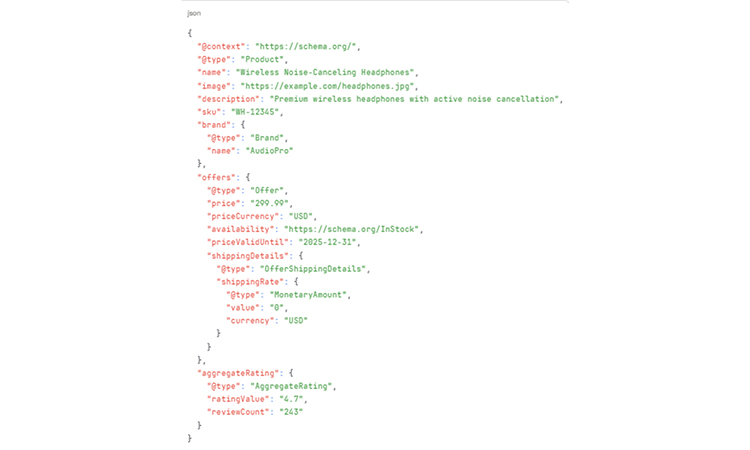
- Internal Linking Strategy Link to related categories, complementary products, and buying guides. Create a web of relevance that distributes SEO authority across your catalog.
How do you implement Internal Links in product-led SEO?
Step 1: Create Content Hubs
- Build pillar pages around main product categories
- Link all related products and content to pillar pages
- Create topic clusters that reinforce topical authority
Step 2: Implement Logical Hierarchy
- Homepage → Category Pages → Subcategory Pages → Product Pages
- Each level should link to the next level and related pages
- Limit critical pages to 3 clicks from the homepage
Step 3: Use Descriptive Anchor Text
- Include relevant keywords naturally in anchor text
- Avoid generic “click here” or “read more” links
- Match anchor text to the target page’s primary keyword
- Vary the anchor text to appear natural
Step 4: Add Contextual Internal Links
- Link from blog content to relevant product pages
- Connect complementary products (cross-selling)
- Link comparison pages to individual product pages
- Connect user guides to the products mentioned
Step 5: Optimize Navigation Links
- Ensure main navigation reaches key category pages
- Implement breadcrumb navigation with schema markup
- Add related products sections on product pages
- Include “You might also like” recommendations
Step 6: Monitor and Fix Broken Links
- Audit internal links quarterly
- Fix 404 errors immediately
- Update outdated links
- Remove or redirect deprecated pages
Best Tools:
- Screaming Frog SEO Spider (internal link audit)
- Ahrefs Site Audit (broken link detection)
- Google Search Console (crawl error reports)
- Link Whisper (WordPress internal linking suggestions)
- Unique Content for Variants- Each product variation needs distinct content. Don’t duplicate descriptions for different colors or sizes. Explain specific benefits: “Navy blue conceals stains better for everyday wear.”
On-Page SEO Checklist
Title Tag Formula: [Primary Keyword] | [Benefit or Specification] | [Brand Name] Example: “Waterproof Hiking Boots for Women | Lightweight & Durable | OutdoorGear”
H1 Best Practice: Keep it natural and specific. Include your primary keyword, but write for humans first.

Meta Description: Write 150-160 characters that include your keyword, a benefit, and a call to action. Example: “Shop waterproof hiking boots for women. Lightweight, breathable designs with ankle support. Free shipping over $50. Browse now.”
Conversion Hooks: Free Trial, PQL Indicator, Micro-Conversions
Free Trial or Sample Options: Offer try-before-you-buy programs. “Order 3 samples for $5” reduces purchase anxiety and increases conversion rates for higher-ticket items.
Product Qualified Lead (PQL) Indicators: Add “notify me when back in stock” buttons, size recommendation tools, or “save to wishlist” features. These capture leads even when visitors don’t immediately purchase.
Micro-Conversions: You can develop small engagement steps before the main purchase:
- “View in your room” AR visualization
- “Email me this product” sharing option
- “Compare with similar items” feature
- Quick-view modals for faster browsing
- “Calculate your savings” tools
Mini-Template for Programmatic Landing Pages
You can use this structure to scale hundreds of targeted landing pages:
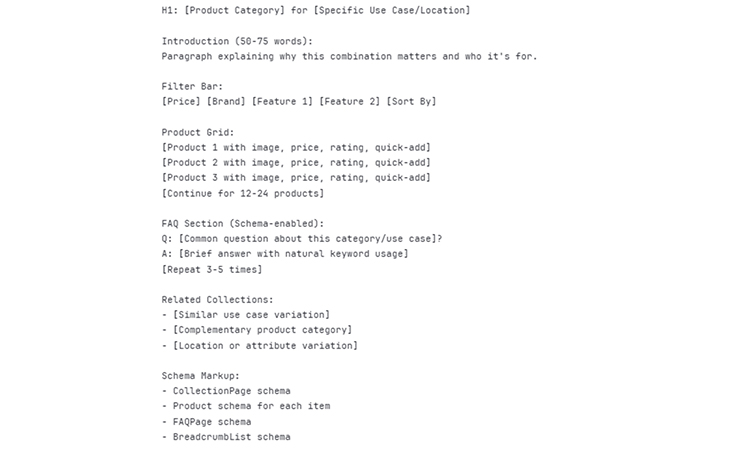
Tools for programmatic page generation:
- Shopify Flow (for Shopify stores)
- WooCommerce Product Tables (for WordPress)
- Custom scripts using your product API
- Webflow CMS (for template-based generation)
This same template works because it balances SEO requirements with user experience. Visitors find exactly what they searched for, products are immediately visible, and conversion barriers are minimized.
Pillar 2-How Do You Do Keyword Research for Product-Led Growth?
Keyword research for product-led growth SEO (PLG SEO) is not about writing random blogs. You need to find the exact terms where your product’s features and user needs meet. Here’s how ecommerce brands can do it step by step:
Framework For PLG Keyword Research
- Search Intent: First, you need to identify whether the query shows purchase intent (e.g., “buy running shoes online”) or informational (e.g., “best running shoes for flat feet”).
- Product Fit: Check if your product can directly solve that query. If not, skip it.
- Volume/Opportunity: Use search tools to see if enough people search for it. Even low search volume terms can be valuable in ecommerce if they convert.
- Scalability: Can this keyword type be scaled into tens of thousands of variations using programmatic SEO?
Best Keyword Research Tools & Tactics to Find Relevant Product-Led Growth SEO Keywords
- Seed Keywords from Product Features: You can start with what your product offers (e.g., “Nike running shoes,” “wireless earbuds”). The best keyword research tool tells all the important metrics of choosing high-value keywords for your ecommerce website.
- Google Analytics 4 (GA4) + Shopify Search Data: Check what customers are already typing in your site search or what converts in GA4 reports.
- Competitor SERP Scraping: Look at sites like Amazon or Shopify competitors; tools like Ahrefs or Semrush show their ranking pages.
- Programmatic Keyword Clustering: Tools like SEOClarity or Keyword Insights group thousands of variations into themes (e.g., size, color, location).
How To Research Product-Led Growth Keywords in Semrush?
- Log in to Semrush.
- Go to Keyword Overview.
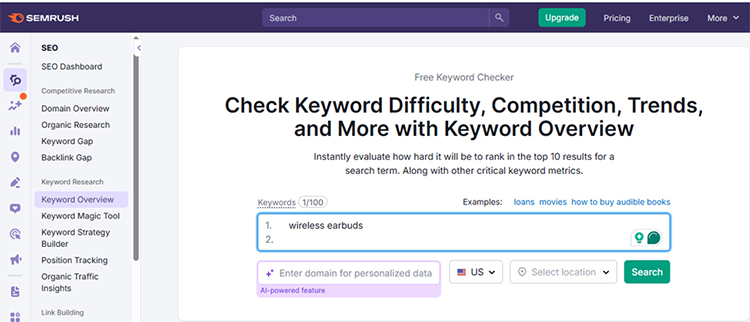
- Type in your product’s features (e.g., “wireless earbuds,” “running shoes,” “Shopify apps”).
- This gives you a broad view of search volume, difficulty, and trends.
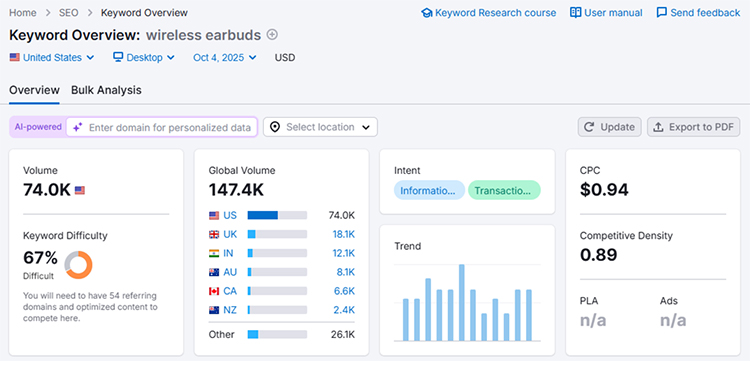
Then you can click- Keyword Magic Tool in Semrush.And then you get this brief list.
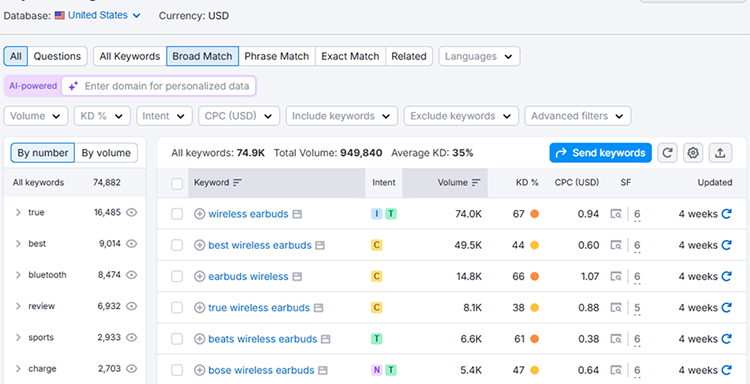
| Metric | Definition | Best Tips For PLG SEO |
| Search Volume | The average number of times a keyword is searched per month. It shows the level of demand for a term. | Don’t ignore low search volume keywords — in e-commerce, long-tail queries (e.g., “red running shoes size 9”) have high purchase intent and can add up when scaled with programmatic SEO. |
| Keyword Difficulty (KD) | A score (0–100) that shows how hard it is to rank for a keyword based on competitors’ authority and backlinks. | For faster wins, target low to medium KD (20–50) keywords with strong product fit. Competing on high KD keywords is harder unless your site already has strong authority. |
| CPC (Cost Per Click) | The average cost advertisers pay for a click on Google Ads for that keyword. It indicates commercial value. | High CPC = strong buying intent. If CPC is high, but KD is low or medium, it’s an ideal keyword for e-commerce conversion-focused landing pages. Use it to boost organic growth without paying per click. |
Check Competitor Keywords
- Go to Domain Overview → enter a competitor’s domain
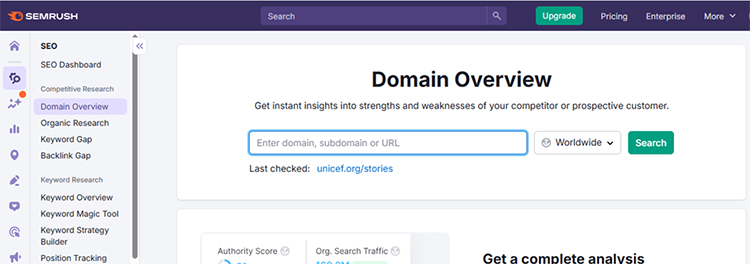
This tool gives you an overview of which keywords your rival website uses and you don’t. So you can include them and rank your website higher in search engine results.
That’s how you can research keywords and include them in your content to dominate the search engine results. There are various completely free keyword research tools (Google Keyword Planner, Google Trends) available, so you can also take help from them.
Pillar 3—Branded Content & Business Benefits
Branded content in product-led growth SEO doesn’t mean writing generic blogs that don’t have anything to do with your products. You should develop content that proves business value and attracts potential customers to your valuable product, specifically. So you need to have a deep understanding of which kind of content you will produce and where to place it.
Important fact: B2B companies make twice as much money from organic search as from any other channel. This means that search engine optimization is an important investment for long-term growth.
Where Should You Place Product-Led Content?
Blog / Branded Content Strategy- Your blog should highlight business value at every encounter. Each piece supports awareness and creates empathy with potential customers before linking directly to relevant product pages.
How to structure branded content:
- Step 1: First, you need to recognize customer pain points through keyword research and customer interviews. Look for questions your potential customers ask repeatedly. Then you need to add the product’s benefits.
- Step 2: After that, you can post content that focuses on solutions and naturally brings up your product as the answer to these problems. You need to have a deep understanding of your primary audience’s needs.
- Step 3: Include clear internal links from blog posts to specific product pages, not just your homepage. Link contextually where the product solves the problem you’re discussing.
SaaS Example: A project management tool writes “How to Reduce Meeting Time by 40%” and links to their meeting automation features throughout the article.
E-commerce Example: A furniture store publishes “Small Space Living: 15 Storage Solutions” and links to specific storage products mentioned in each tip.
Critical statistic: Content creation leads to 434% more indexed pages than websites without updated content, dramatically increasing your search traffic opportunities.
Microsites & Subfolders: When to Use Each
Use subfolders (yoursite.com/category/) when:
- Content directly relates to your main brand.
- You want to pass domain authority to new pages.
- Develop topical authority for your niche.
- Moreover, you can develop programmatic pages for product variations.
Use microsites (separate domains) when:
- You can change your target audience to reach a wider market.
- Then you may examine new markets or product lines.
- Most importantly, you have to create industry-specific solutions to improve the product-led approach.
- After that, you can develop location-specific presences
Pro tip: Most ecommerce brands benefit more from subfolders because they consolidate search engine rankings under one domain and build stronger topical authority.
How to Combine Branded Content with a Product-Led Organic Growth Strategy?
The role of Branded Content in your SEO Strategy involves
Product-led SEO focuses on conversion-ready pages, but branded content plays three vital roles:
- Nurture Trust Before Purchase- You can write content with high knowledge and information. When potential customers research solutions, your helpful educational guides position you as the expert.
- Capture Branded Queries-Once people know your brand, they’ll search for “[Your Brand] vs [Competitor]” or “[Your Brand] reviews.” Creating content for these queries controls your narrative in search results.
- Defend SERP Real Estate- Own multiple positions on page one. If you rank for both informational and transactional queries, competitors have fewer opportunities to capture your customers.
Powerful statistic: 27.6% of clicks go to the first search result alone, so you need to uprank your website to capture search traffic.
Content Types That Promote Product Value
Case Studies (Customer-Centric Approach) Show real customers solving real problems with your product. Include specific metrics and outcomes.
Format: Challenge → Solution → Results with measurable data.
ROI Calculators (Interactive Content): Let visitors input their numbers to see potential savings or returns. These tools rank for “[product] ROI calculator” while simultaneously demonstrating value.
Deep Tutorials (Educational Value): Step-by-step guides that teach people how to accomplish goals using your product. These rank for “how to” queries while subtly showcasing features.
Comparison Pages (Competitive Positioning): Create honest comparisons between your product and alternatives. This captures high-intent searches from people evaluating options.
SaaS insight: Product-led SEO integrates search engine optimization directly into the product experience, making every feature page a potential ranking opportunity.
Ecommerce insight: Comparison pages for “Product A vs. Product B” capture buyers in the final decision stage and often convert 3-5x better than general category pages.
Internal Linking Strategy: Content → Product Pages → Trial/Demo
Follow a Product Qualified Lead (PQL) funnel structure:
Step 1: Awareness Stage- Blog posts and guides link to relevant product category pages. Use descriptive anchor text that includes target keywords.
Step 2: Consideration Stage- Product pages link to comparison content, case studies, and detailed feature pages. Help visitors understand why your solution fits their needs.
Step 3: Decision Stage- All product pages prominently feature calls-to-action for trials, demos, or purchases. Remove friction from the conversion process.
Internal linking best practice-Every piece of content should have 3-5 internal links to related content and at least 1-2 links to product pages where contextually relevant.
Critical statistic- The average conversion rate for SEO is 2.4%, but product-led content with clear conversion paths converts 2-3X higher because it attracts new users. That’s how you can improve your user engagement.
Repurposing User-Generated Content (UGC) and Reviews as Content Creation
User-generated content is SEO gold that most e-commerce stores underutilize.
Why UGC matters for search engines:
- Adds fresh, unique content regularly
- Includes natural long-tail keywords customers actually use
- Builds trust signals that improve search engine rankings
- Answers real questions potential customers ask
Game-changing statistic: Product reviews by customers are trusted 12x more than brand marketing, making review content incredibly powerful for conversions.
Another key statistic: 88% of consumers trust online reviews as much as personal recommendations, directly impacting purchase decisions.
How to leverage UGC for SEO growth:
Step 1: Create Review-Based Landing Pages- Turn customer reviews into standalone content. “Customer Reviews: Best Running Shoes for Marathon Training” aggregates relevant reviews and ranks them for review-focused queries.
Step 2: Feature Q&A Sections-Customer questions and answers create natural long-tail keyword content. Each question becomes a potential search query your page can rank for.
Step 3: Build “Real Customer Stories” Pages-Compile testimonials and photos from customers using products in specific ways. “Real Customers: How Our Standing Desk Changed Their Work Day.”
Step 4: Implement Review Schema Markup-Add structured data to show star ratings in search results. Rich snippets improve click-through rates by 30%, and it will bring more qualified search traffic.
Step 5: Encourage Detailed Reviews-The more detailed the reviews are, the more long-tail keywords they naturally contain. Incentivize customers to explain how they use products and what problems they solve.
SaaS application: Software companies can showcase user-submitted use cases, turning customer stories into SEO-optimized content that ranks for industry-specific searches.
Ecommerce application: Fashion retailers can feature customer photos with product reviews, creating visual UGC that ranks in image search while building trust.
The Complete Product-Led Content Ecosystem
The most successful product-led growth SEO strategies don’t choose between branded content and product-led content—they integrate both.
Your ecosystem should include:
- Educational blog posts that build trust
- Product pages optimized for transactional searches
- Comparison content for evaluation-stage buyers
- User-generated reviews create authentic social proof.
- Interactive tools demonstrating product value
- Case studies proving ROI
Each content type serves a specific search intent while guiding visitors toward conversion. This customer-centric approach ensures you’re creating content that actually helps people while building sustainable seo organic growth.
Pillar 4 — Technical Foundation to improve Product-led Growth SEO
Technical SEO forms the backbone of sustainable SEO efforts. Even the best product-led content will have a hard time ranking and reaching your primary audience if it doesn’t have a solid technical foundation. In this guide, you will discover every important technical element for product-led growth SEO with implementation steps and tools.
Site Speed Optimization: Foundation of Sustainable SEO
Site speed is how fast your pages load and become usable. Fast sites keep existing users engaged and improve search engine rankings.
Impact on conversion rates: Conversion rates tend to drop dramatically with each second of delay. Even a 0.1-second improvement in page speed can transform the buyer journey and significantly boost conversions.
Critical statistics:
- One major retailer saw a 10% increase in website speed, resulting in a 2% uplift in eCommerce revenue.
- A Deloitte and Google study found that even a 0.1-second improvement in page speed made a significant difference in conversions.
- Sites with poor speed potentially lose 50% of visitors who abandon before the page fully loads.
Implementation Steps:
Step 1: Measure Current Performance
- Run Google PageSpeed Insights for every key page type.
- Test on both mobile and desktop.
- Document baseline scores before optimization.
Step 2: Optimize Images
- Compress all images using tools like TinyPNG or ImageOptim.
- Implement lazy loading for below-fold images.
- Use WebP format for better compression.
- Add width and height attributes to prevent layout shift.
Step 3: Minimize JavaScript and CSS
- Remove unused JavaScript and CSS.
- Defer non-critical JavaScript.
- Inline critical CSS for above-fold content
- Use code splitting for large JavaScript files.
Step 4: Leverage Browser Caching
- Set appropriate cache headers for static assets.
- Use a content delivery network (CDN) for faster global delivery.
- Implement service workers for offline functionality.
Step 5: Optimize Server Response Time
- Upgrade hosting if necessary.
- Use server-side caching (Redis, Varnish).
- Optimize database queries.
- Implement HTTP/2 or HTTP/3.
Best Tools:
- Google PageSpeed Insights (performance measurement)
- GTmetrix (detailed speed analysis)
- WebPageTest (advanced testing options)
- Cloudflare or Fastly (CDN services)
- WP Rocket or NitroPack (WordPress speed optimization)
Core Web Vitals: Google’s User Experience Metrics
Core Web Vitals is a group of metrics that check how fast, interactive, and stable a webpage’s visuals are. It is one of Google’s page experience ranking signals.
The three critical metrics (2024 onwards):
- Largest Contentful Paint (LCP): Measures loading performance. Target: under 2.5 seconds
- Interaction to Next Paint (INP): Starting March 2024, INP replaced First Input Delay (FID) as one of the three Core Web Vitals metrics. Target: under 200 milliseconds
- Cumulative Layout Shift (CLS): Measures visual stability. Target: under 0.1
Why it is important: Poor Core Web Vitals directly impact rankings and user experience. Your primary audience abandons pages with poor vitals, and you potentially lose customers before they see your products.
Implementation Steps:
Step 1: Audit Current Core Web Vitals
- Use Google Search Console’s Core Web Vitals report.
- Identify which pages fail each metric.
- Prioritize high-traffic product pages first.
Step 2: Fix LCP (Loading Speed)
- Optimize the largest image or text block on the page.
- Preload LCP resources in HTML head.
- Remove render-blocking resources.
- Use CDN for faster content delivery.
- Ensure LCP images are discoverable early in page load.
Step 3: Improve INP (Interactivity)
- Break up long JavaScript tasks.
- Optimize event handlers.
- Use web workers for heavy computations.
- Minimize third-party scripts.
- Prioritize main thread efficiency.
Step 4: Reduce CLS (Visual Stability)
- Set explicit dimensions for images and videos.
- Reserve space for ads and embeds.
- Avoid inserting content above existing content.
- Use CSS transform instead of changing position properties.
- Preload fonts to prevent font swapping.
Best Tools:
- Google Search Console (Core Web Vitals report)
- Chrome DevTools (Lighthouse audit)
- Web Vitals Chrome Extension (real-time monitoring)
- PageSpeed Insights (detailed recommendations)
- Cloudflare (automatic optimization features)
Mobile Optimization: Meet Your End Users Where They Are
Mobile optimization ensures your site provides excellent experiences for end users on smartphones and tablets, where most ecommerce browsing happens.
Reality check: Over 71.8% of e-commerce traffic comes from mobile devices. If your site isn’t mobile-optimized, you potentially lose the majority of your primary audience.
Implementation Steps:
Step 1: Implement Responsive Design
- Use flexible grid layouts that adapt to screen sizes.
- Test on multiple device sizes (320px to 768px widths).
- Ensure touch targets are at least 48×48 pixels.
- Use readable font sizes (minimum 16px for body text).
Step 2: Optimize Mobile Navigation
- Simplify menu structures for thumb navigation.
- Make the search prominent and easy to access.
- Implement sticky “Add to Cart” buttons.
- Reduce form fields to the minimum required.
Step 3: Accelerate Mobile Load Times
- Prioritize mobile Core Web Vitals.
- Reduce image sizes specifically for mobile.
- Minimize redirects that slow mobile loads.
- Consider AMP (Accelerated Mobile Pages) for content.
Step 4: Test Mobile User Experience
- Use real devices for testing, not just desktop simulators.
- Test on various network speeds (3G, 4G, 5G)
- Check touch interactions and gesture controls.
- Verify the checkout process works smoothly on mobile.
Best Tools:
- Google Mobile-Friendly Test (mobile compatibility check)
- BrowserStack (test on real mobile devices)
- Chrome DevTools Device Mode (mobile simulation)
- Google Analytics (mobile behavior analysis)
URL Structure: Creating SEO-Friendly Paths
URL structure determines how web addresses are formatted, affecting both search engine understanding and user experience.
Best practices for product-led SEO:
- Keep URLs short, descriptive, and keyword-rich
- Use hyphens to separate words (not underscores)
- Avoid unnecessary parameters and session IDs
- Create a logical hierarchy reflecting the site structure
Implementation Steps:
Step 1: Design URL Hierarchy

Step 2: Include Target Keywords
- Place the primary keyword in product URLs
- Keep brand name in URL when relevant
- Avoid keyword stuffing in URLs
Step 3: Handle Product Variations

Use separate URLs for significantly different variations, parameters for minor ones.
Step 4: Implement Canonical Tags
- Set canonical URLs for duplicate or similar content
- Prevent pagination issues with rel=”canonical”
- Handle filter and sort parameter URLs properly
Best Tools:
- Shopify/WooCommerce (platform URL settings)
- Yoast SEO (WordPress URL optimization)
- Screaming Frog (URL structure audit)
XML Sitemaps: Helping Search Engines Discover Content
Definition: XML sitemaps list all important URLs on your site, helping search engines discover and index your product pages efficiently.
Critical for product-led SEO: As you scale programmatic pages, sitemaps ensure search engines discover thousands of new landing pages quickly.
Implementation Steps:
Step 1: Generate Comprehensive Sitemaps
- Include all product pages
- Add category and collection pages
- Include important content pages
- Exclude low-value pages (admin, duplicate content)
Step 2: Organize by Content Type
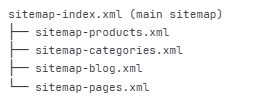
Step 3: Include Essential Information
- URL (required)
- Last modification date (helps prioritize crawling)
- Change frequency (weekly for products, daily for blog)
- Priority (0.8-1.0 for key product pages)
Step 4: Submit to Search Engines
- Submit to Google Search Console
- Moreover, you can add to Bing Webmaster Tools
- Add sitemap reference in robots.txt
Step 5: Update Automatically
- Configure automatic sitemap regeneration
- Update when products are added or removed
- Ping search engines on significant changes
Best Tools:
- Yoast SEO (automatic WordPress sitemaps)
- Shopify (built-in sitemap generation)
- XML Sitemap Generator (custom sitemap creation)
- Google Search Console (sitemap submission and monitoring)
Security & HTTPS: Building Trust with Users
HTTPS encrypts data between your server and existing users, protecting sensitive information and building trust.
SEO impact: HTTPS is a confirmed ranking factor. Sites without HTTPS potentially lose rankings and customer trust, directly affecting conversion rates.
Implementation Steps:
Step 1: Obtain an SSL Certificate
- Purchase from a trusted certificate authority
- Many hosts offer free SSL (Let’s Encrypt)
- Install the certificate on your server
Step 2: Redirect HTTP to HTTPS
- Implement 301 redirects from HTTP to HTTPS
- Update all internal links to use HTTPS
- Verify redirects work correctly
Step 3: Update External References
- Change canonical tags to HTTPS
- Update social media links
- Modify email signatures and marketing materials
Step 4: Fix Mixed Content Warnings
- Ensure all images load via HTTPS
- Update third-party scripts to HTTPS
- Check for HTTP resources on HTTPS pages
Best Tools:
- SSL Labs Server Test (SSL configuration check)
- Why No Padlock (mixed content detection)
- Cloudflare (free SSL and performance improvements)
What Are Programmatic & Product-Led SEO Best Practices and Common Pitfalls?
When you successfully integrate SEO into product development, every new feature becomes a ranking opportunity. This approach has helped companies that created tens of thousands of landing pages scale organic traffic without proportional increases in content teams.
Best Product-Led SEO Practices to Increase Your Business Value
- Avoid Targeting the Same Keywords Across Multiple Pages – Keyword cannibalization confuses search engines and dilutes your ranking power. So you need to strategically choose unique keywords for each page on your website.
- Create Unique Value for Each Programmatic Page – Don’t just swap product names in templates. Add distinct descriptions, local insights, or use-case-specific information.
- Prioritize Existing Customers’ Needs—You can create pages based on actual questions and problems that your current users face. Their search behavior guides valuable content creation.
- Set Quality Thresholds—If a programmatic page has fewer than 5 relevant products or less than 150 words of unique content, don’t publish it.
- Implement Proper Internal Linking—Connect programmatic pages to your main category structure and related content hubs.
Common Mistakes You Can Avoid To Improve Product-Led Growth SEO Efforts
- Thin Content at Scale: If you publish thousands of pages that feature only that product list, you will be penalized for quality.
- Duplicate Content Problems: When the same templates are used without enough variation, duplicate content issues arise, which lowers a website’s overall ranking.
- Bad User Experience: Search engine-optimized pages that are not user-friendly fail both audiences.
Let’s Conclude Our Discussion
At the end of our discussion, it’s very evident that if SaaS companies need to flourish their brand, they need to implement product-led growth SEO. So, in the whole conversation, you can get all the important tips and strategies for implementing product-led growth SEO in SaaS companies. Remember, it’s important to prioritize user experience and customer satisfaction to promote organic growth and increase brand visibility.
Yes, you can create your own strategy. But you can take help from the professional ecommerce SEO company. They can provide useful information and expertise to help optimize your SEO efforts and encourage organic traffic to your SaaS product.
So don’t think too much; implement SEO for PLG (Product-Led Growth) properly, and it will rank your website without a sales team.

